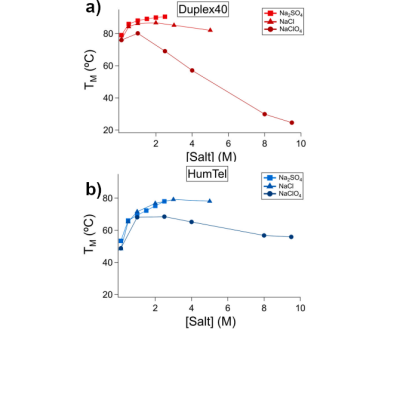
The Hofmeister series ranks ions based on their propensity to exert diverse effects on solvents and their associated solutes. On one end are chaotropes which are ions that generally destabilize secondary structure. On the other end, kosmotropes generally stabilize secondary structure. Here, the authors observed that G quadruplexes are comparatively insensitive to the presence of anionic chaotropes, but not other denaturants. G quadruplexes consist of Watson-Crick/Hoogsteen hydrogen-bonded quartets with a central channel of coordinated cations. G quadruplexes are present in critical regions of the genome, but it is unknown exactly how biological systems regulate the equilibrium between non-G quadruplex states and DNA and RNA sequences that can form G quadruplexes.
The authors found that G-quadruplexes exhibited significantly less destabilization under increasing concentrations of sodium perchlorate compared to i-Motifs and duplex DNA. The CD spectra for G quadruplexes was consistent with a switch from an antiparallel topology to a hybrid one. A G-quadruplex with one additional tetrad exhibited a similar conformational shift while a G-quadruplex with one tetrad removed did not. Thus, in perchlorate solutions, G-quadruplexes with varying numbers of stacked tetrads differ in their response to sodium perchlorate.
The authors utilized urea, a neutral detergent, to examine the impact of the cationic component of sodium perchlorate independent of perchlorate-induced effects. In fixed salt concentrations with varying amounts of urea, duplex DNA was slightly more destabilized compared to G-quadruplexes. CD spectra showed that as urea concentrations increased, the G-quadruplexes transitioned to a parallel structure. In solutions with equimolar urea and NaCl, duplex was also more destabilized compared to G-quadruplexes. This agrees with previous studies, since NaCl can overcome the denaturation of G-quadruplexes by urea through central ion binding. This trend held true for a cationic chaotropic (GuCl) as well.
The authors tested additional anionic chaotropic salts- sodium thiocyanate and sodium iodide- which displayed similar effects. This suggests that the behaviors observed are due to the cationic component of these salts and not due to the Hofmeister anion-specific effects.
G-quadruplexes are unique in that destabilizing effects of differentially charged denaturants are mitigated by the presence of a monovalent cation. Monovalent cations mitigate the effects of denaturants by providing electrostatic screening on the surface of all DNA secondary structures, but G quadruplexes also utilize monovalent cations to balance its electronegative core. Internalizing monovalent cations poses an energetic penalty to the system; however, higher concentrations of chaotropic solutes reduces water activity and therefore mitigates this burden. So, G quadruplexes not only have a second means of stabilization using monovalent cations, but the chaotropic system itself is helping encourage this process. The observation of another means by which solutes exhibit differential effects on secondary structure stability studied here was performed in concentrated salt solution. However, protein binding partners for nucleic acids also exhibit chaotropic side chains, such as the guanidinium side chain on arginine. The authors are currently investigating whether similar mechanisms could be operative in more biological systems.
